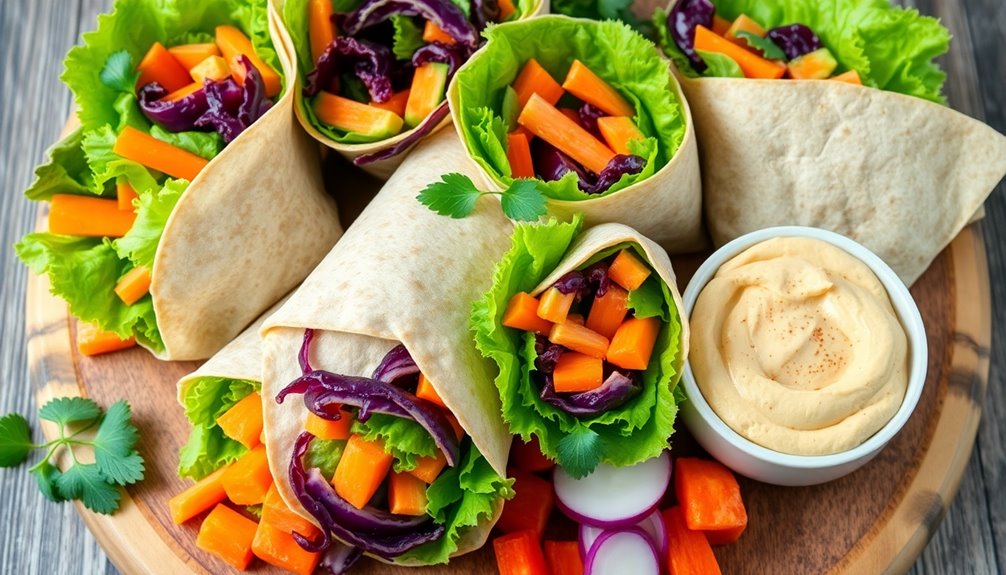Veggie and hummus wraps are not just tasty but also packed with essential nutrients. You get vitamins and minerals from leafy greens and colorful veggies, while hummus provides plant-based protein and fiber. Choosing whole grain or spinach wraps boosts your fiber intake, supporting digestive health. These wraps are low in calories, making them great for weight management. Fresh herbs and spices enhance the flavor, and you can customize ingredients to your liking. To make the most of your wraps and keep them fresh, special storage tips can help maintain their deliciousness. Discover ways to elevate your veggie wraps even further!
Key Takeaways
- Veggie and hummus wraps are nutritious, packed with essential vitamins, minerals, and plant-based protein, supporting a wholesome diet.
- Use whole grain or spinach wraps as a sturdy base, and choose colorful vegetables for added crunch and nutrients.
- Experiment with different hummus flavors and seasonings to elevate the taste of your wraps.
- Wrap tightly and cut diagonally for a visually appealing presentation that enhances the eating experience.
- Store wraps in airtight containers or freeze them for long-term freshness while keeping hummus and veggies separate.
Benefits of Veggie Wraps
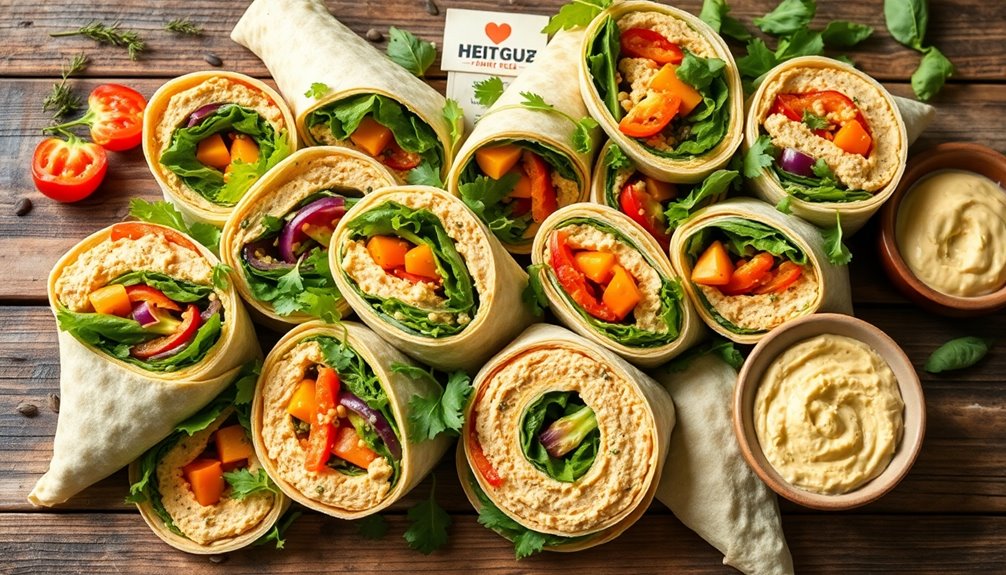
Enjoying veggie wraps can provide a variety of health benefits that make them an excellent addition to your diet. Packed with fresh vegetables, these wraps are loaded with essential vitamins and minerals. For instance, leafy greens like spinach and kale are rich in iron and calcium, while colorful veggies such as bell peppers and carrots offer antioxidants that combat oxidative stress. Incorporating these nutrient-dense ingredients can help support your immune system and overall well-being.
Another significant advantage of veggie wraps is their versatility in flavor combinations. You can mix and match your favorite veggies with various sauces and spices to create a meal that's not only healthy but also exciting. For example, you could use roasted red peppers with a touch of balsamic glaze, or combine cucumbers and tomatoes with a sprinkle of feta cheese for a Mediterranean twist. These flavor combinations can keep your meals interesting and enjoyable, making it easier to stick to a healthier eating pattern.
Additionally, veggie wraps are often lower in calories compared to traditional sandwiches, allowing you to satisfy your hunger without overindulging. They can also be easily customized to suit different dietary preferences, whether you're vegan, vegetarian, or simply looking to reduce meat consumption.
Choosing the Right Hummus
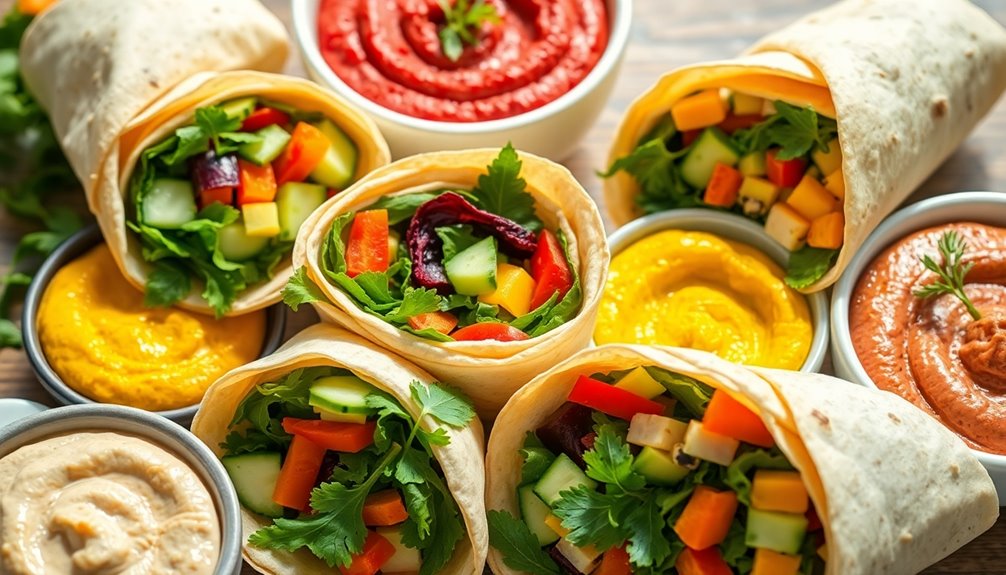
When it comes to enhancing your veggie and hummus wraps, selecting the right hummus can make all the difference in flavor and nutrition. With numerous hummus brands available, it's crucial to take into account your taste preferences and dietary needs.
Start by exploring different hummus flavors; traditional chickpea hummus offers a classic taste, while roasted red pepper or garlic variations can add a zesty twist to your wraps.
When choosing a brand, look for options that use high-quality ingredients. Some brands focus on organic chickpeas and natural flavorings, which can contribute to both taste and health benefits. For instance, brands like Sabra and Tribe offer a variety of flavors and textures, making it easy to find one that suits your palate. You might even prefer local brands that use fresh, seasonal ingredients, giving your wraps a unique and community-oriented touch.
It's also vital to take into account nutritional content. Opt for hummus that's lower in added oils and preservatives, and check for protein and fiber content to make sure your wraps are filling and nutritious. If you're feeling adventurous, you could even try making your own hummus at home, allowing you to control the ingredients and flavors.
Ultimately, the right hummus can elevate your veggie wraps, making them more enjoyable and satisfying. So, take some time to experiment with different hummus flavors and brands until you find your perfect match, creating wraps that not only taste great but also nourish your body.
Essential Ingredients

A successful veggie and hummus wrap relies on a handful of essential ingredients that come together to create a delicious and nutritious meal. When you select the right components, you can enhance flavor combinations and elevate your wrapping techniques. Here are four key ingredients to keep in mind:
- Whole grain or spinach wraps: These offer a sturdy base while adding extra nutrients.
- Fresh hummus: Choose varieties like garlic, roasted red pepper, or lemon to add depth to your wrap.
- Colorful veggies: Consider bell peppers, cucumbers, carrots, and greens for crunch and vibrancy.
- Herbs and spices: Fresh herbs like cilantro or parsley, along with spices like cumin or paprika, can elevate your wrap.
When you combine these ingredients, you'll not only enjoy a burst of flavors but also a range of vitamins and minerals. For example, the fiber from whole grain wraps and veggies supports digestion, while the healthy fats in hummus provide sustained energy.
As you wrap your creations, explore different wrapping techniques. Rolling your wrap tightly ensures that all the delicious ingredients stay intact, making it easier to enjoy on the go. If you're feeling adventurous, attempt folding in the sides before rolling for a more compact option.
Vegetable Varieties
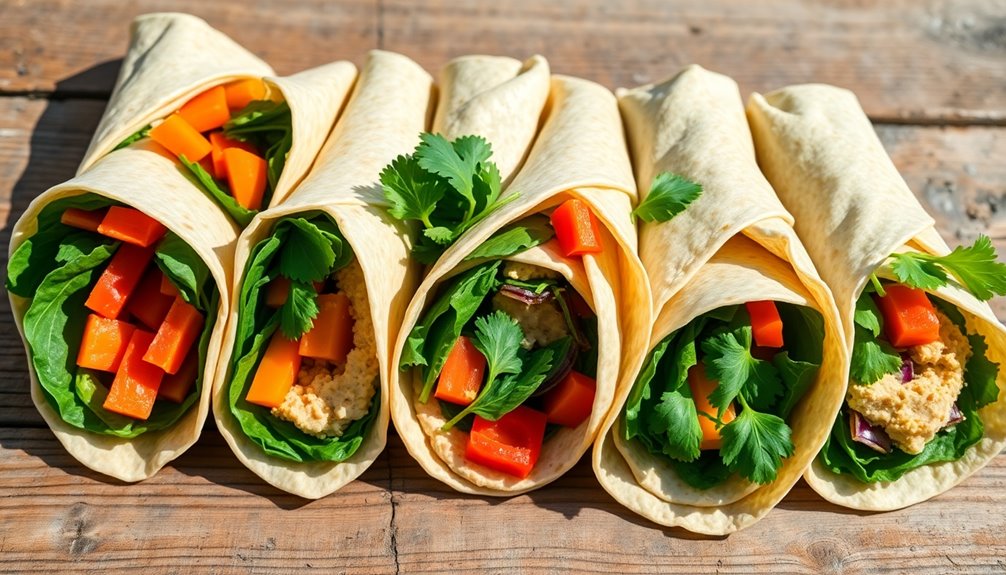
Incorporating a variety of vegetables not only enhances the taste of your veggie and hummus wraps but also boosts their nutritional status. You'll want to embrace seasonal produce, as it's often fresher, more flavorful, and packed with nutrients. Think about adding vibrant bell peppers, crunchy carrots, or crisp cucumbers to your wraps. Each vegetable brings its unique set of vitamins, minerals, and antioxidants, creating a balanced meal that supports your health.
Flavor combinations play an essential role in making your wraps exciting. For instance, the sweetness of roasted red peppers pairs beautifully with the earthiness of spinach. You might also consider adding some zucchini or yellow squash for a mild flavor and added texture. This medley not only keeps your taste buds intrigued but also ensures you're receiving a variety of nutrients from different sources.
Don't overlook herbs! Fresh herbs like cilantro, parsley, or basil can enhance the flavor profile of your wraps, making them even more enjoyable. As you explore different vegetable varieties, remember that incorporating a mix of colors can lead to a more visually appealing dish, which contributes to the overall experience.
Step-by-Step Preparation
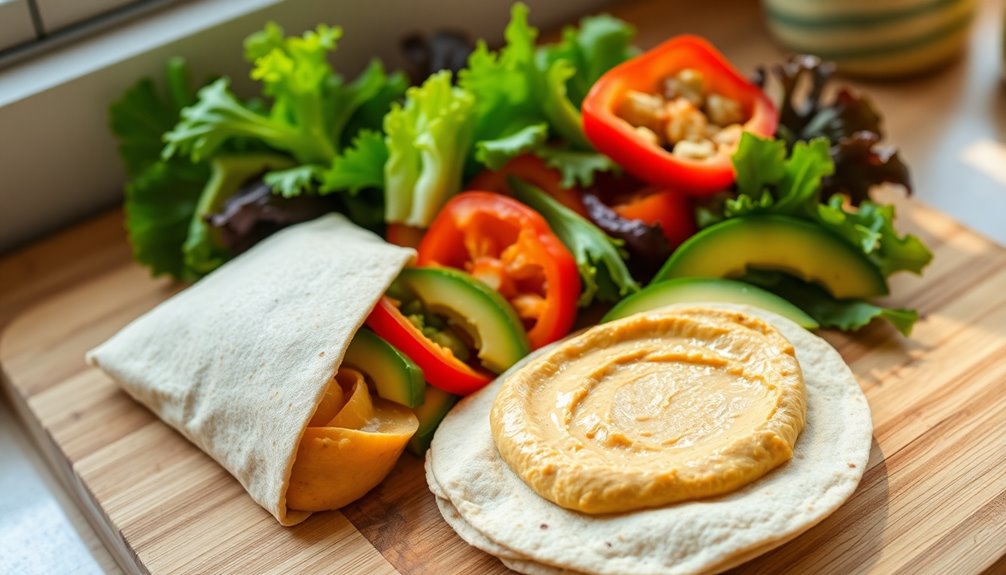
Preparing veggie and hummus wraps is a straightforward process that anyone can master. You'll soon find that with just a few simple steps, you can create a delicious, nutritious meal that's perfect for any occasion. Here's a quick guide to get you started:
- Choose your favorite vegetables, such as bell peppers, cucumbers, and spinach.
- Select a high-quality hummus; consider different flavors to elevate your wraps.
- Gather your ingredients: tortillas, seasoning options, and any additional toppings.
- Experiment with different wrapping techniques for the best presentation.
Start by laying out your tortilla flat on a clean surface. Spread a generous layer of hummus across the center, leaving some space around the edges. This not only adds flavor but also helps in keeping the filling from spilling out.
Next, arrange your vegetable slices in a colorful array, ensuring a mix of textures and flavors. For added zest, sprinkle some seasoning options like salt, pepper, or even a dash of paprika.
Now, it's time to roll! Use a firm yet gentle motion to wrap the tortilla around the filling, tucking in the sides as you go. This wrapping technique will keep your ingredients secure and enhance the overall presentation.
Once wrapped, slice the roll in half to reveal the vibrant colors and textures inside. Enjoy your veggie and hummus wraps as a quick meal or a shareable snack, knowing you've created something healthy and delightful.
Customizing Your Wrap
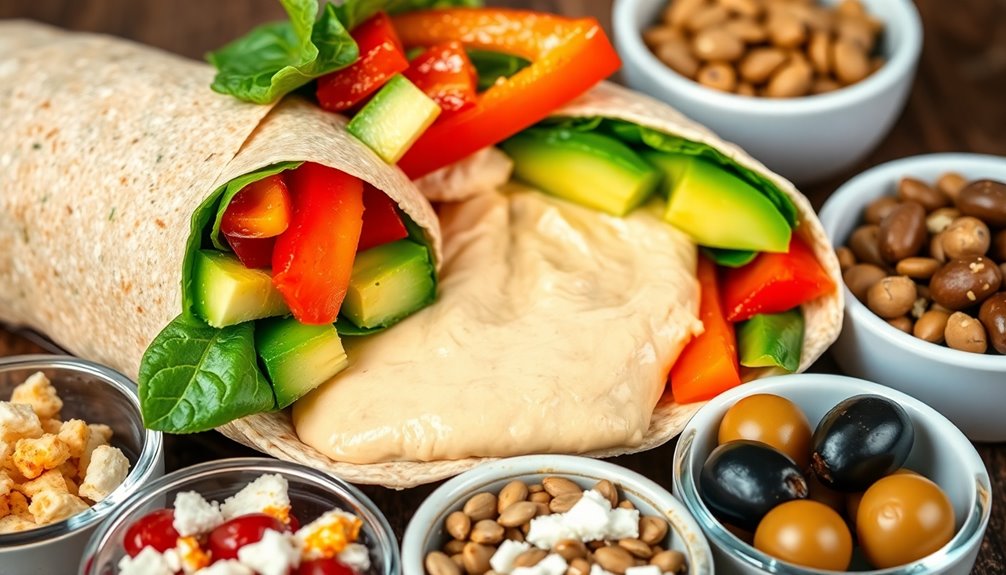
Once you've mastered the basic veggie and hummus wrap, it's time to make it your own. Customizing your wrap allows you to explore an array of flavor combinations that resonate with your taste buds and dietary preferences. Start by experimenting with different types of hummus. From garlic to roasted red pepper, each spread adds a unique twist that can elevate your wrap. Pair your hummus with a variety of vegetables—think crunchy bell peppers, creamy avocado, or zesty pickles. Mixing textures not only enhances the flavor but also makes your wrap visually appealing.
Don't overlook proteins! Adding chickpeas, grilled chicken, or even feta cheese can turn your veggie wrap into a satisfying meal. You can also incorporate fresh herbs like cilantro or basil for an extra burst of flavor.
When it comes to wrapping techniques, practice makes perfect. A tight wrap guarantees that all the delicious ingredients stay together and makes for an easier eating experience.
Start by laying your ingredients in the center of your tortilla, then fold in the sides before rolling it up from the bottom. Try different types of tortillas—whole grain, spinach, or even gluten-free options—to find what you enjoy most.
Serving Suggestions
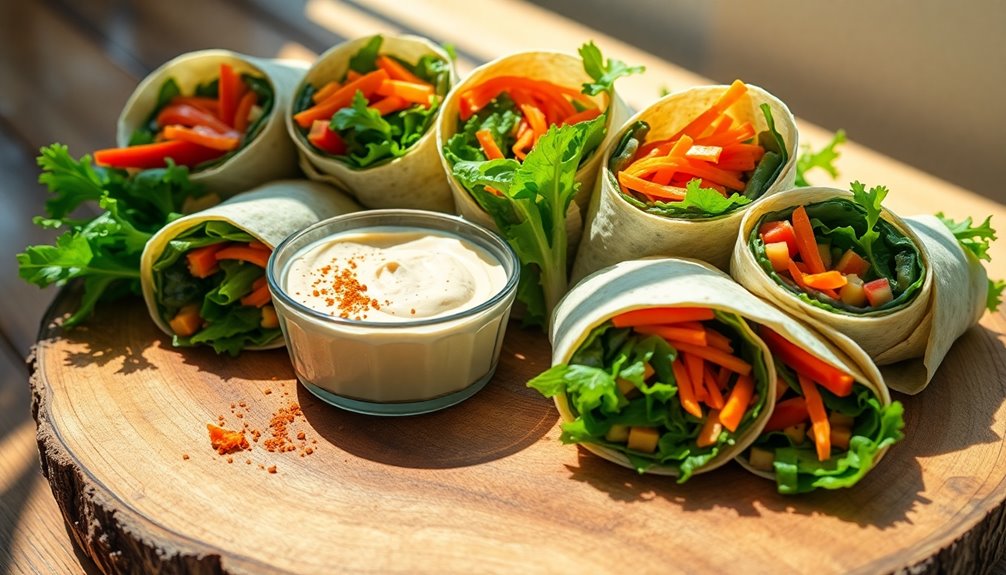
Serving your veggie and hummus wraps can transform a simple meal into an inviting experience. When you focus on presentation and flavor combinations, you not only enhance the visual appeal but also create a more enjoyable dining atmosphere for everyone. Here are some presentation tips to elevate your wraps:
- Use colorful vegetables like bell peppers, carrots, and purple cabbage for a vibrant look.
- Cut your wraps diagonally to showcase the filling and make them easier to eat.
- Serve with a side of assorted dips, such as tzatziki or guacamole, for added flavor.
- Garnish with fresh herbs like parsley or cilantro to add a pop of color and freshness.
For plating suggestions, consider using large, colorful plates or wooden boards that complement the natural hues of your ingredients. Arrange the wraps neatly, allowing each one to stand out.
You might also want to add a small bowl of hummus on the side for dipping, which invites guests to personalize their meal.
Garnish ideas can range from a sprinkle of sesame seeds to a drizzle of balsamic glaze, enhancing both the flavor and presentation. Don't forget to offer a variety of flavor combinations, such as roasted red pepper hummus paired with crunchy cucumbers or spicy hummus with roasted vegetables.
Nutritional Information
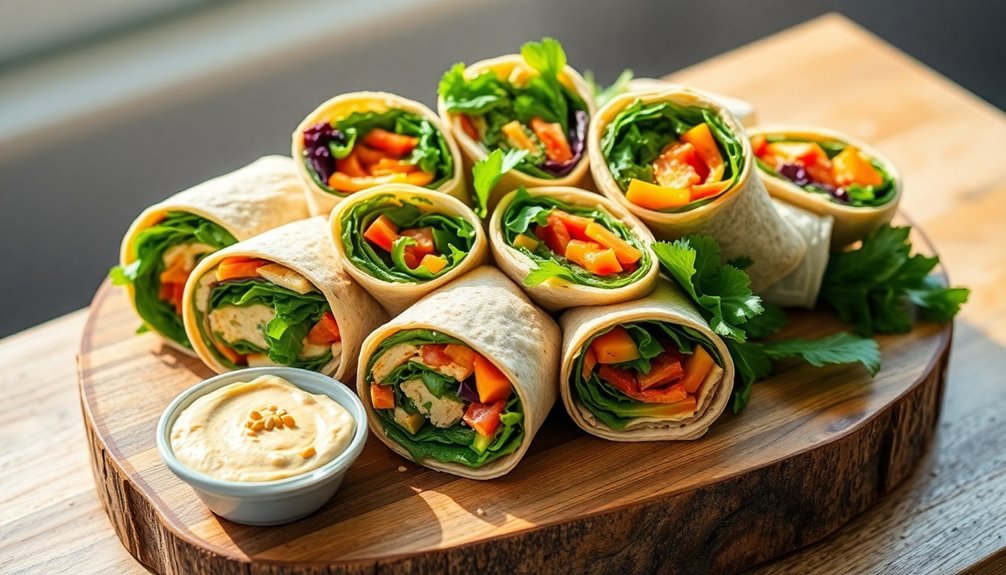
Nutritionally, veggie and hummus wraps offer a well-rounded meal option that frequently combines essential vitamins, minerals, and healthy fats. When you bite into a wrap filled with colorful vegetables and creamy hummus, you're not just enjoying a tasty treat; you're also fueling your body with nutrients. Vegetables like spinach, bell peppers, and carrots provide an array of vitamins, including vitamin A and C, which support your immune system and skin health.
Hummus, made primarily from chickpeas, is a fantastic source of plant-based protein and fiber, which can help keep you full and satisfied. This balance can be particularly beneficial if you're looking to manage your weight or maintain energy levels throughout the day.
For the best health benefits, it's important to take into account the recommended portion of your wrap. Aim for a serving that includes about one cup of mixed vegetables and two to three tablespoons of hummus. This portion ensures you're getting a good mix of nutrients without overdoing it on calories.
Moreover, using whole grain or spinach wraps can boost the fiber content, promoting digestive health. By incorporating veggie and hummus wraps into your diet on a regular basis, you're embracing a wholesome and vibrant way of eating that not only nourishes your body but also connects you to a community that values healthy choices. So, grab your ingredients, and enjoy a delicious wrap that's as nourishing as it's satisfying!
Storage Tips
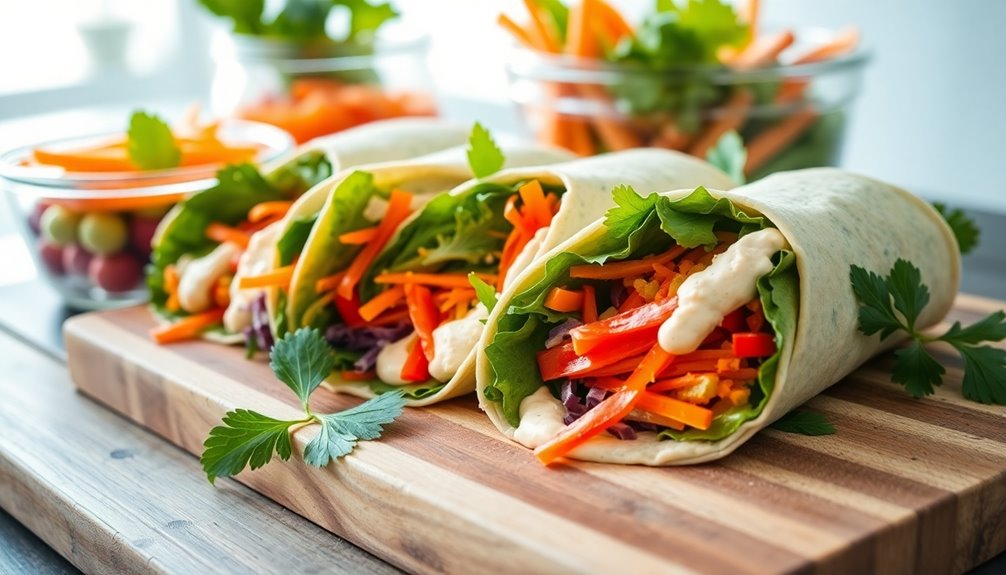
To keep your veggie and hummus wraps fresh and tasty for longer, proper storage is essential. By following some effective refrigeration techniques and storage methods, you can enjoy your wraps even days after making them.
Here are some key tips for ideal storage:
- Wrap tightly: Use plastic wrap or foil to securely seal your wraps. This prevents air from getting in, maintaining freshness.
- Use airtight containers: If you prefer, place your wraps in an airtight container. This can help keep them from drying out or absorbing odors from your fridge.
- Separate ingredients: For long-term storage, consider keeping the hummus and veggies separate until you're ready to eat. This helps prevent sogginess and keeps everything crisp.
- Label and date: If you're preparing multiple wraps, label them with the date. This helps you keep track of freshness and prevents waste.
When it comes to long-term storage, you can freeze your wraps. Just make sure to wrap them tightly in plastic wrap and place them in a freezer-safe bag. When you're ready to eat, thaw them in the fridge overnight and enjoy them the next day.
Creative Variations
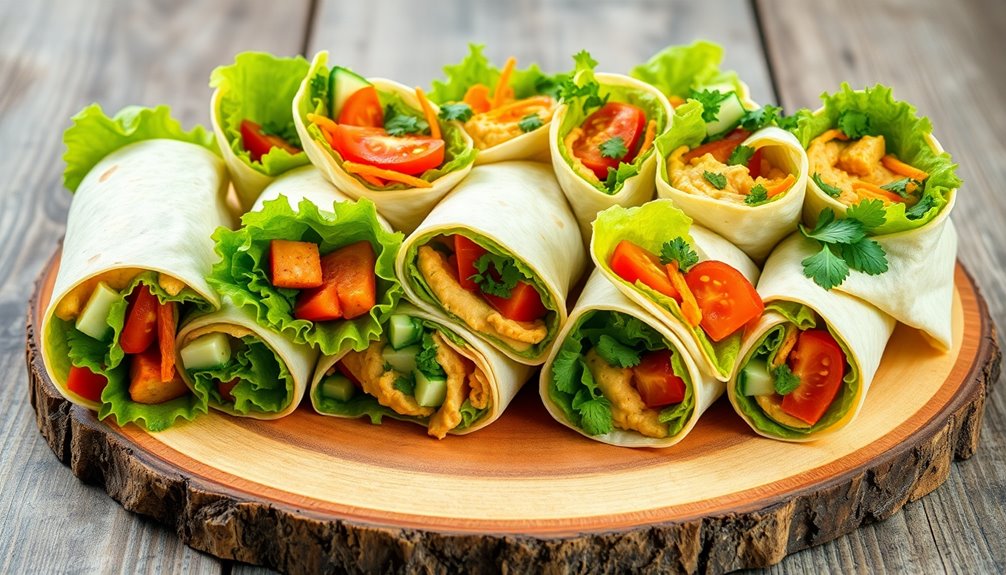
There's no shortage of ways to elevate your veggie and hummus wraps beyond the classic combination. You can start by experimenting with flavor combinations that tickle your taste buds. Consider adding roasted red peppers or sun-dried tomatoes for a burst of sweetness. If you're craving something spicy, a dash of sriracha or jalapeños can add a kick that's hard to resist.
Presentation ideas can also make a big difference. Try cutting your wraps into pinwheels or serving them alongside colorful veggie sticks. This not only enhances visual appeal but also makes them more fun to eat, especially for gatherings or lunchboxes.
Don't forget about ingredient substitutions to suit your preferences or dietary needs. Swap traditional hummus for avocado spread or a spicy bean dip to create a whole new experience. If you're looking for a gluten-free option, use lettuce leaves instead of tortillas—your wraps will still be delicious and satisfying.
Meal prep suggestions can save you time during busy weeks. Prepare your veggies in advance, store them in airtight containers, and whip up your wraps in minutes. You can even freeze some wraps for a quick grab-and-go meal.
With these creative variations, you'll not only enjoy a delightful eating experience but also feel a sense of belonging among fellow food lovers who appreciate the art of customization. Happy wrapping!
Frequently Asked Questions
Can I Use Gluten-Free Wraps for Veggie and Hummus Wraps?
Absolutely, you can use gluten-free wraps for your meal! There are plenty of wrap alternatives that cater to different dietary needs. Look for options made from rice, corn, or even lentils.
When it comes to fillings, you can explore various hummus variations, like roasted red pepper or garlic, to enhance flavors. Using gluten-free wraps guarantees you can enjoy a delicious meal while accommodating dietary preferences, making everyone feel included and satisfied.
What Are Some Good Protein Sources to Add?
Picture a vibrant, colorful plate filled with fresh ingredients, and consider adding plant-based proteins to boost your meal's nutrition.
You can toss in nuts and seeds for a satisfying crunch or include tofu and tempeh for a hearty texture.
Quinoa is another fantastic choice, offering a nutty flavor while packing in protein.
These options not only enhance your dish but also provide a sense of belonging to a community that values healthy eating.
How Long Do Wraps Stay Fresh in the Fridge?
Wraps typically stay fresh in the refrigerator for about three to five days, depending on their ingredients. To maximize shelf life, store them in an airtight container or tightly wrap them in plastic. Proper storage helps with preservation, keeping your wraps delicious and safe to eat.
Always check for signs of spoilage before consuming. By following these tips, you'll guarantee you enjoy your wraps at their best for longer!
Are There Any Allergens in Typical Hummus Recipes?
When you're diving into hummus, it's crucial to know about potential allergens. Many recipes include tahini, which is made from sesame seeds, so if you've got sesame sensitivity, you'll want to be cautious.
Additionally, some hummus may contain nuts, posing a risk for those with nut allergies.
Always check the ingredient list or make your own to guarantee it's safe. Being informed helps you enjoy delicious dips while keeping everyone safe.
Can I Freeze Veggie and Hummus Wraps for Later?
Yes, you can freeze veggie and hummus wraps for later! For the best results, use proper wrapping techniques—wrap them tightly in plastic wrap or aluminum foil to prevent freezer burn.
Freezing tips include placing parchment paper between wraps if you're stacking them, making it easier to separate later.
When you're ready to enjoy, just thaw in the fridge overnight. This way, you'll have a quick, nutritious meal ready whenever you want!
Conclusion
Incorporating veggie and hummus wraps into your meals can boost your nutrition, enhance your energy, and satisfy your taste buds. By choosing fresh vegetables and flavorful hummus, you create a dish that's not only delicious but also versatile. Whether you're enjoying them as a quick lunch, a snack on the go, or a healthy dinner option, these wraps offer endless possibilities. So, roll up your wraps, savor the flavors, and nourish your body with every bite.

